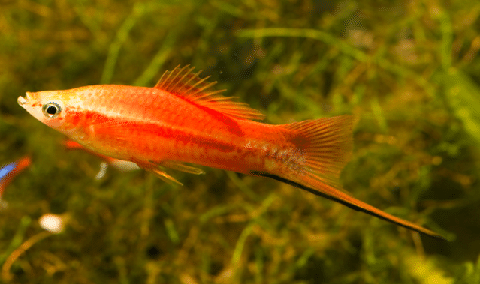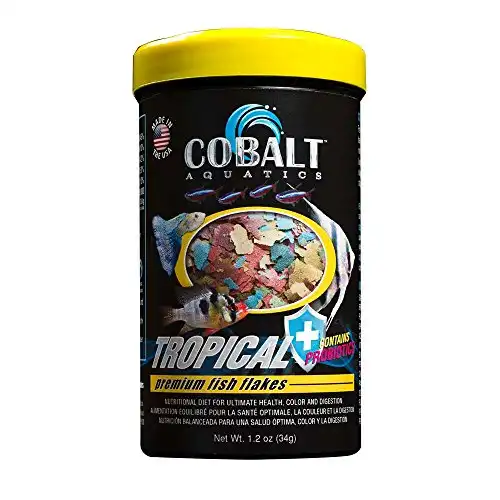Thank you for visiting! By the way… any links on this page that lead to products on Amazon and other stores/partners are affiliate links Aquarium Store Depot earns a commission if you make a purchase.
Are you thinking of adding a swordtail fish to your tank? If so, you’re in for a treat! These energetic and colorful little fish make great additions to any community tank. But before you add one to your tank, there are some things you need to know about their care. In this guide, we’ll provide everything you need to know to keep your swordtail fish happy and healthy. So read on and learn all about these fascinating fish!
A Brief Overview Of The Swordtail Fish
| Scientific Name | Xiphophorus hellerii |
| Common Names | Specific names depend on coloration; widely referred to as swordtail fish |
| Family | Poeciliidae |
| Origin | North America and Central America |
| Diet | Omnivore |
| Care Level | Easy |
| Activity | Peaceful |
| Lifespan | 3 – 5 years |
| Temperament | Peaceful |
| Tank Level | All levels |
| Minimum Tank Size | 20 gallons |
| Temperature Range | 64 ° to 82 °F |
| Water Hardness | 1 – 12 dKH |
| pH Range | 7.0 – 8.2 |
| Filtration/Water Flow | Moderate to high |
| Water Type | Freshwater |
| Breeding | Livebearer |
| Difficulty to Breed | Easy |
| Compatibility | Community tanks |
| OK, for Planted Tanks? | Yes |
Swordtail Fish Origins and Habitat
Swordtails are one of the most easily recognizable freshwater fish in the entire aquarium hobby. The swordtail fish have been bred to display all colors and pattern variations while still maintaining their status as being one of the easiest species to keep in the freshwater aquarium. These aquarium fish didn’t start out like this, though.
Instead, swordtails originate from North and Central America, specifically from Veracruz in Mexico to northwestern Honduras. There, they are found in a variety of ecosystems with varying altitudes, turbidities, depths, water flows, and even salinities. Most often, they are found in relatively shallow systems with dense vegetation. Adults are likely to be in areas of high flow while juveniles will stick towards the margins where conditions are calmer.
Unfortunately, swordtail fish have entered the waterways of many nonnative continents and countries. They are largely found throughout portions of South America, Africa, and Australia where their invasive populations harm native species1. Most of these populations have been established through aquarium releases.
Originally, these freshwater species were known as green swordtail fish due to their natural green bodies and red accents. Through the years, these swordtail fish were very carefully bred for color and pattern combinations which eventually led to the overwhelming array of choices available today.
As we’ll see though, colors aren’t the only thing that has changed about the swordtail fish.
How Long Do Swordtails Live?
Swordtails can live a surprisingly long time. On average, the swordtail fish is expected to live 3-5 years in good water and tank conditions.
For some hobbyists, this can be a problem.
Swordtails, like other livebearing species, are prolific breeders. Anytime there is a male and female swordtail fish present in the tank, there are likely to be baby swordtails. Adding a swordtail to an aquarium can potentially limit hobbyists in their future livestock additions due to reproduction rates and overstocking.
What Do They Look Like?

Swordtails are very recognizable due to their famous feature: their tail that resembles a sword!
On average, swordtail fish grow to be about 5 inches, though they can measure up to 6 inches and can become quite plump. They have a wide, torpedo-shaped body and round stomach. They are unique in that their dorsal fin is higher than other tropical freshwater fish and the bottom ray of their caudal fin extends well past the rest of their tail.
This extension makes sexing swordtail fish easy. Males have this feature while females do not; females have a rounded caudal fin with no other special markings and resemble a platyfish (Xiphophorus maculatus). Males are also typically more colorful and smaller than their female counterparts.
The most common color for swordtails to come in is red; the whole body will be red with a noticeable darker mid-lateral line, especially on the males. The fin extension may also be a different color from the rest of the body or have different colored margins depending on the variety of fish.
Swordtail Varieties
Once originally known as the green swordtail, beautiful though plain in color, these aquarium fish have been selectively bred to display almost every color and every pattern combination, mostly consisting of reds, yellows, and oranges.
It should be noted that swordtails have successfully been hybridized with other species within the Xiphophorus genus, making the possibilities endless.
Here are some of the most common colors to come across as well as the most designer swordtail varieties available:
Red swordtail. The red swordtail fish is the most common variation to come across. Both males and females are uniform in color, though males may have a black margin to their tail fin extension.
Red wag swordtail. The red wag swordtail is a normal swordtail but with black fins. All other features and requirements are the same as the regular red swordtail.
Pineapple swordtail. The swordtail fish with the best name, these swordtails have a red back with a pale yellow body and white belly. They may have slightly shorter fin extensions than other varieties, which can be a favorable combination along with their colors.
Red lyretail swordtail. These swordtail fish are named after the instrument as both males and females have a u-shaped tail fin. The body is light orange/red while the dorsal and tail fins are usually black.
Hi fin lyretail swordtail. An even more accentuated version of the red lyretail swordtail, the hi fin attribute comes from the extremely elongated dorsal fin which is almost as long as their tails; females do not have such exaggerated features. Colors include red, orange, and yellow. Because of their extreme features, hi fin lyretail swordtails need at least a 30-gallon tank and very carefully chosen tank mates that won’t nip at fins.
Are They A Type Of Molly Fish?
Mollies, platies, swordtails. They all kind of look the same and have similar care requirements, but what makes them different?
Swordtails are not a type of molly or platy, even though they are all closely related. Looking at the scientific categorization of these freshwater species, swordtails are Xiphophorus hellerii, mollies are Poecilia latipinna, and platies are Xiphophorus maculatus.
As we can see, mollies are in a different scientific genus altogether. However, swordtails are in the same genus, Xiphophorus, as platies and are very closely related. Though there are slight variations between these two species–namely, the absence of the elongated tail fin in platies–there is a larger difference in geographic distribution.
The Xiphophorus genus is split into three phylogeographic clades based on origin. Platies are native to eastern Mexico and Central America. Northern swordtails are found in very specific regions of northeastern Mexico. Southern swordtails, like the ones listed in this article, originate from southern Mexico and northern Central America.
Care – Temperament and Activity Level
Swordtail fish are a favorite among beginner hobbyists due to their flashy and active behavior. These fish will quickly fill up empty space in the upper and middle portions of the tank, only venturing to the bottom for food.
While great additions to the community tank, swordtails can be slightly aggressive towards each other, specifically from male to male. As we’ll see, it’s recommended to keep a very high male-to-female ratio to keep males from becoming aggressive to one another. Males may also become aggressive to similar-looking fish of other species.
Otherwise, these active fish will provide constant movement to the aquarium display. When they’re not looking for food to pick off of plants and decorations, they’ll be looking to mate.
What Are Good Tank Mates for Swordtails?
Swordtails are compatible with most freshwater fish. They are big enough to tolerate larger, slightly more aggressive species while bringing out the best in smaller, schooling types.
The most important thing to consider when choosing swordtail fish tank mates is fin nipping. These fish have beautiful fins that you don’t want to see get shredded or infected with fin rot!
Here are some of the best tank mates for swordtails:
Remember that swordtail fish are capable of hybridizing with platies. While this isn’t necessarily wrong to allow happen, hybridization can lead to some genetic mutations and loss of color lineages.
It should also be noted that keeping swordtails with other prolific livebearers, like platies or guppies, can quickly lead to overpopulation if not controlled.
How Many Swordtails Should Be Kept Together?
Contrary to popular belief, swordtail fish are not a schooling species. They like to be in group settings but won’t actively follow around the other swordtails in the tank for protection.
That being said, swordtail fish do best when kept in groups of 4 to 6. At least two or three females should be kept for every one male. Hobbyists have had success keeping only one male swordtail fish in a tank–which is the preferred setting if wanting to avoid any chances of reproduction–but they will thrive in a social community setting.
Since male and female fish are so easy to tell apart, it is recommended to skip a male addition altogether. However, keep in mind that there is the chance for females to already be pregnant before adding them to your tank.
Can Bettas and Swordtails Live Together?
Another great beginner fish is the Betta (Betta splendens). These fish are nowhere near as active as the swordtail fish but males are especially colorful with bold personalities. So much so that betta fish are notorious fighting fish that could easily injure a swordtail if paired together.
Because of this, bettas should not be attempted to live with swordtails. These two fish are not compatible tank mates as swordtails are overly active and can become fin nippers. This could stress out your betta and lead to infection.
What Do They Eat?
Swordtail fish are omnivores and will gladly eat whatever they are given. They will love foraging for food on live plants and other decorations, but will readily accept an assortment of live, frozen, and freeze-dried foods, like bloodworms, brine shrimp, and mosquito larvae.
To maintain their color, a high-quality tropical fish flake food or pellet should be offered daily; quality flake food is slightly more preferred as they stay at the water’s surface longer. Swordtail fish may also be given algae pellets or flakes as well as blanched vegetables from time to time.
Best Tropical Fish Flake Food
Cobalt offers a premium level flake food with probiotics. A color enhancing formula that works great for all tropical fish
What Plants Do They Eat?
While foraging for food on live plants, swordtail fish have been known to accidentally–or purposely–eat some leaves.
Swordtails are great algae eaters and will help keep plants free from pests. However, they are so efficient that they might not be able to tell algae apart from a desired live plant. This behavior can be deterred by feeding more often or adding less desired plants that are meant to be eaten.
Setting Up Your Tank
Swordtails are very hardy fish and can live in a variety of aquarium setups. Like any fish, swordtail fish need to be kept in a fully cycled aquarium with stable water parameters. Swordtail fish can be slightly messier than other freshwater fish so it’s important that the mechanical and biological filtration systems are ready to handle the bioload.
Swordtail fish look especially great in a densely planted aquarium on a dark substrate. They will need an aquarium hood to prevent them from jumping out.
Tank Size
Swordtail fish are one of the more demanding beginner species when it comes to tank size. These fish are relatively big, active, and need to be kept in small groups. They can also create a lot of bioload for so few fish.
To help bolster the biological filtration system and to give your swordtail fish enough space to swim, a 20 gallon long tank is recommended. A long tank will give much more space for your fish to swim than a tall tank. Even bigger tanks will allow for a much larger selection of fish to choose from.
Filtration
To keep up with bioload, the filter should be rated for at least 2x the size of the aquarium. In regards to swordtail fish, it’s pretty difficult to give too much filtration.
If you remember, these fish live in areas of high flow in their natural habitat. Though most swordtails in the aquarium hobby have adapted to living in community tanks with minimal flow, swordtail fish can surely survive a tank set up with a high water current.
The Best Aquarium Power Filter
The worlds best selling and most reliable power filter on the market. Unchanged for years because it's so reliable and versatile
This water flow can be created with filters, powerheads, and wavemakers. Just remember that other community fish might not be able to handle such high water currents as well as your swordtail fish.
Water Parameters
Swordtail fish are very forgiving of incorrect water parameters, but that doesn’t mean that you shouldn’t strive to give them the best. Like any other fish, swordtails will succumb to sudden fluctuations in water parameters.
Swordtails can be kept in a cooler water temperature, though stability is key. A changing water temperature can quickly cause fish to go into shock, so a heater for temperature regulation is strongly recommended. It is also advised to keep swordtail fish in tropical water temperatures in order to have the most choices when it comes to possible tank mates.
Otherwise, swordtail fish need a neutral pH level with limited nitrates.
Breeding
Breeding swordtail fish is straightforward and usually a matter of when rather than if. Swordtails are livebearing fish which means that they will give birth to live young.
First, get a good mix of female and male swordtails. Some hobbyists choose to remove their mating pairs from the main tank display into a specific breeding tank, though this isn’t entirely necessary.
Once ready, males will chase after females and the two fish will mate. Over the next few weeks, the female will grow plumper in appearance until she’s ready to give birth. When she’s ready, she will birth anywhere from 50-200 live fry. Not to mention that females can give birth once every month or so!
The fry will be immediately independent and susceptible to being eaten by the parents and other fish; this usually isn’t a concern as the brood is so large and reproduction can happen so often.
To increase the chances of fry surviving, they should be placed in their own tank or given plenty of coverage in the form of live plants. Small foods, like baby brine shrimp, will need to be offered until they are ready to accept larger foods.
Final Thoughts
Swordtail fish are a popular addition to beginner hobbyist’s fish tanks. These swordtail fish are big, active, and easy to care for but do require some special attention when it comes to water flow and keeping males together.
Otherwise, these peaceful fish are fun and easy to breed, allowing hobbyists to make their own designer swordtail varieties along the way!
- About the Author
- Latest Posts
I’m thrilled that you found Aquarium Store Depot! Here you’ll find information on fish, aquariums, and all things aquatics related. I’m a hobbyist (being doing this since I was 11) and here to help other hobbyists thrive with their aquariums! I adhere to a high quality Editorial Process and Review products with real life field usage and practical analysis.







